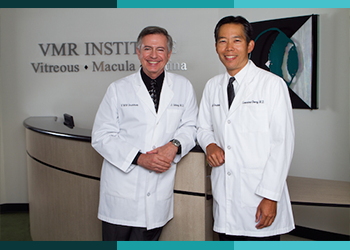Treatment
Developing novel treatments to cure diseases of the Vitreous, Macula, and Retina.
The VMR Institute offers all standard therapies as well as a variety of novel treatments to cure diseases of the Vitreous, Macula, and Retina. Our in-office cryotherapy unit and solid state laser are available on-site to treat diabetic retinopathy, retinal vein occlusions, retinal breaks, and retinal detachment. Dr. Sebag has aided the American Academy of Ophthalmology to teach laser eye surgery.
In-Office Repair of Retinal Detachments
Dr. Sebag has vast expertise in treating retinal detachments in the office, without the need for hospitalization. Their excellent results have been presented at national and international meetings and the results have been published in the professional literature.
Related Publications
Drug Therapy
Injections are available on-site at the VMR Institute in Huntington Beach, Orange County for macular degeneration, diabetic retinopathy, and retinal vein occlusions. The VMR Institute previously participated in four separate national, multi-center clinical trials in these conditions, and our experience exceeds that of anyone in the community.
Cryotherapy
Non-invasive retinal cryotherapy is available on-site at the VMR Institute to treat retinal holes/tears and neovascular glaucoma.
Microsurgery
Sutureless microsurgery is an area of expertise at the VMR Institute for Vitreous Macular Retina.
This advanced form of therapy is superior to the older method (still practiced by many other doctors in the area) and decreases operating time while increasing the speed of vision recovery with less time off work.
In 2008 Dr. Sebag was selected to establish a state-of-the-art vitreo-retinal microsurgery service at the Newport Bay Surgery Center in Newport Beach, Orange County.
Drug Therapy Replaces Vitreous Surgery
The surgical removal of vitreous is often necessary for complex diseases of the Vitreous, Macula, and Retina inside of the eye. However a new form of therapy, known as pharmacologic vitreolysis, is being developed to replace surgery. The VMR Institute has participated in six national and international clinical trials to improve this surgery using novel drug therapy. Dr. Sebag has published seminal articles on this topic.


